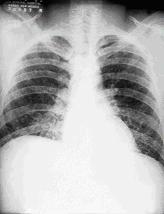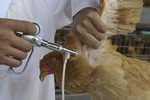California has plan


State Formula Determines Who Gets Shots During Bird Flu Pandemic
AP
SAN FRANCISCO, September 9, 2006 - California health officials have settled on a formula for resolving a wrenching question that would arise if a bird flu pandemic strikes the state: who gets doses of scarce vaccine?
The complex process for picking who would receive bird flu shots is contained in the state's Pandemic Emergency Preparedness and Response Plan. State officials completed a new version of the plan last week, and a copy was obtained late Friday by The Associated Press.
The state did not draw up a hierarchy of Californians who would most need inoculation, though it hints at groups most vulnerable. "Very young persons, elderly adults, and persons with underlying disease are at high risk of complications during interpandemic influenza outbreaks," it states.
Instead of setting out a list of likely candidates, the state developed a scoring system that the report says "produces a rank-ordered list of target groups prioritized for influenza vaccination." The formula is designed to be flexible enough to accommodate variables in a pandemic.
Click Me!
The system considers:
* The goals of a vaccination program, such as minimizing illness, social disruption and economic losses.
* Rationing strategies, such as emphasizing people who perform essential emergency-services roles or who are especially vulnerable to disease.
* Precise criteria for determining who qualifies as a member of those critical or vulnerable groups.
The state's formula represents a new attempt to grapple with the subject of a fierce debate over who should be inoculated in a worst-case scenario.
Vaccine factory employees and front-line health workers head the Bush administration's own list, but there is no consensus on who would get vaccinated next. Should it be school-age children who are flu's prime spreaders? The frail elderly who may be at highest risk of death? Police, firefighters, utility workers who would have to keep order and essential services running?
Congress allocated $3.8 billion last year with the goal of being able to distribute vaccine to every American within six months of a pandemic striking. The Bush administration leaves it up to states to determine how to distribute the vaccines.
While several pharmaceutical companies are conducting clinical trials, no vaccine currently exists. It would take time for researchers to develop a highly effective vaccine after they identified a lethal bird flu strain.
"It becomes a high-stakes process to the extent there's a shortage of vaccine, and early on, that's certainly likely to be the case," said Dr. Mark Horton, the state public health officer and chief deputy director in the California Department of Health Services.
The state plan envisions beginning vaccinations when a pandemic reaches the World Health Organization's "Phase 6" - the most severe stage in a pandemic. At that stage, "sustained" human-to-human spread of the disease is occurring.
Currently, the virus has not mutated into a form easily spread among people. But the deadly Asian strain of bird flu has ravaged poultry and killed at least 141 people worldwide.
The state released a draft bird-flu response plan in January. For nearly nine months, it worked on improvements. But the version released this month contained only "relatively minor, technical" changes, Horton said.
However, it is sure to evolve in the coming months and years. For instance, Horton said, it currently has no specific guidance on another potentially grisly issue - what to do with a large number of dead bodies.
California, the nation's most populous state, is uniquely vulnerable the virus arriving via birds or people. In addition to having a citizenry with ties to Asia, where the disease has hit hardest, California has a $2.5 billion poultry industry, and millions of birds migrate along its flyways.
State Fish and Game authorities have spent the past few weeks trying to catch some of those migrating birds, with limited success. They have been focusing especially on pintails, a type of duck with an exceptionally wide range of migration, said agency spokesman Patrick Foy.
Pintails fly all the way to Alaska and Siberia, where their flyways can intersect with those of birds that have traveled through Asia, Foy said.
Copyright © 2006 KABC-TV and the Associated Press. All rights reserved. This material may not be published, broadcast, rewritten, or redistributed.











 News Editor
News Editor







 James Steckelberg, M.D.
James Steckelberg, M.D. 





